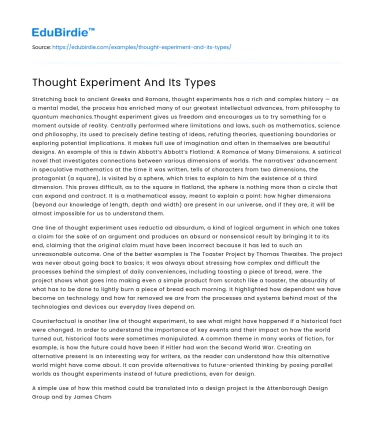Stretching back to ancient Greeks and Romans, thought experiments has a rich and complex history — as a mental model, the process has enriched many of our greatest intellectual advances, from philosophy to quantum mechanics.Thought experiment gives us freedom and encourages us to try something for a moment outside of reality. Centrally performed where limitations and laws, such as mathematics, science and philosophy, its used to precisely define testing of ideas, refuting theories, questioning boundaries or exploring potential implications. It makes full use of imagination and often in themselves are beautiful designs. An example of this is Edwin Abbott’s Abbott’s Flatland: A Romance of Many Dimensions. A satirical novel that investigates connections between various dimensions of worlds. The narratives’ advancement in speculative mathematics at the time it was written, tells of characters from two dimensions, the protagonist (a square), is visited by a sphere, which tries to explain to him the existence of a third dimension. This proves difficult, as to the square in flatland, the sphere is nothing more than a circle that can expand and contract. It is a mathematical essay, meant to explain a point: how higher dimensions (beyond our knowledge of length, depth and width) are present in our universe, and if they are, it will be almost impossible for us to understand them.
One line of thought experiment uses reductio ad absurdum, a kind of logical argument in which one takes a claim for the sake of an argument and produces an absurd or nonsensical result by bringing it to its end, claiming that the original claim must have been incorrect because it has led to such an unreasonable outcome. One of the better examples is The Toaster Project by Thomas Thwaites. The project was never about going back to basics; it was always about stressing how complex and difficult the processes behind the simplest of daily conveniences, including toasting a piece of bread, were. The project shows what goes into making even a simple product from scratch like a toaster, the absurdity of what has to be done to lightly burn a piece of bread each morning. It highlighted how dependant we have become on technology and how far removed we are from the processes and systems behind most of the technologies and devices our everyday lives depend on.
Save your time!
We can take care of your essay
- Proper editing and formatting
- Free revision, title page, and bibliography
- Flexible prices and money-back guarantee
Counterfactual is another line of thought experiment, to see what might have happened if a historical fact were changed. In order to understand the importance of key events and their impact on how the world turned out, historical facts were sometimes manipulated. A common theme in many works of fiction, for example, is how the future could have been if Hitler had won the Second World War. Creating an alternative present is an interesting way for writers, as the reader can understand how this alternative world might have come about. It can provide alternatives to future-oriented thinking by posing parallel worlds as thought experiments instead of future predictions, even for design.
A simple use of how this method could be translated into a design project is the Attenborough Design Group and by James Chamber. The project is a fictional organisation that opens up new environmental perspectives by proposing that if objects were fitted with sensors, they would be able to avoid danger and survive longer before landfilling. For example a portable hard drive with legs that can sense a liquid spill and a radio that sneezes to free itself from dirt. It has added advantage of maintaining strong emotional relations with their owners due to carefully designed animal-like actions that encourage people to project feelings on them. Chamber has been able to shift focus from visual aesthetics to the design for technology products with animal-inspired behaviours.
What-if scenarios are similar to counterfactuals, but more forward-looking where it helps the author to strip a narration and outline the basics to develop a concept. Take John Wyndham who wrote several notes about what-ifs based on invasions of different types of aliens, not just the outer space, intergalactic variety, which he calls logical fantasy. His piece is a large-scale theoretical thinking about how British society will respond to major events and how life will change as a result. Reflecting on one major event, an escape from a genetically modified killer plant laboratory, followed by relatively straightforward consequences. Exploring what might happen in extreme circumstances in a society, a kind of literary practice involving people, leaders, government, media and the army, unpicking where, why and how things might break down or go wrong.
By using design language, designers too, can build things that create similar levels of thoughts and satisfaction. Atelier Van Lieshout’s SlaveCity-Cradle to Cradle and discusses the size of the city that could be sustained if we used humans as slaves to produce energy themselves or as raw materials. It also discusses in depth how economically the city will operate and its optimum size, further exploring how to design such a process, how much space, the building archetypes, and types of equipment and machineries required.






 Stuck on your essay?
Stuck on your essay?

